Evaluation of Hydrogenation Kinetics and Life Cycle Assessment on Mg2NiHx–CaO Composites
Abstract
1. Introduction
2. Experimental Procedure
2.1. Specimen Preparation and Characterization
2.2. Life Cycle Assessment (LCA)
2.2.1. Goal and Scope
2.2.2. Impact Assessment Categories and Environmental Impact Methodology
3. Results and Discussion
3.1. Evaluation of the Synthesized Composites
3.2. Life Cycle Assessment on Composites Prepared
4. Conclusions
Author Contributions
Funding
Institutional Review Board Statement
Informed Consent Statement
Data Availability Statement
Conflicts of Interest
Nomenclature
| Eco-Indicator 99’ | As a lifecycle impact assessment tool developed by Consultants B.V., designers can perform environmental assessments of products by calculating environmental mark scores for used materials and processes. |
| ISO 14000 series | Environmental management life cycle assessment principles and framework, Korean Agency for Technology and Standard, 2007. |
| Global warming potential (GWP) | In a relative sense, it is a type of index based on a simplified radiative characteristic that can be used to measure the possible future impacts of the evolution of various gases on the climate system in the future. |
| ODP (ozone layer depletion potential) | It is a numerical expression of the degree of destruction of compounds that destroy ozone. Based on the ozone depletion capacity of CFC-11 as 1, the destructive power of the remaining chemicals was assumed. |
| AP (acidification potential) | Acidification occurs primarily when nitrogen oxides (NOx) and sulfur dioxide gas (SO2) interact with other atmospheric components. |
| EP (eutrophication potential) | It refers to a phenomenon in which nutrients are excessively supplied to water due to the inflow of chemical fertilizers or sewage, causing rapid growth or extinction of plants and killing organisms by taking away oxygen from the water. |
| ETP (ecotoxicity potential) | Ecotoxicity refers to the ecological impacts of chemicals, pesticides, and pharmaceuticals on freshwater organisms and the possible risks to the aquatic ecosystem. |
| Human toxicity potential (HTP) | Total emissions are assessed in terms of benzene and toluene equivalents, but potential doses include multiple routes of exposure, including inhalation, ingestion, and dermal contact of fish and meat. |
References
- Ryi, S.K.; Han, J.Y.; Kim, C.H.; Lim, H.; Jung, H.Y. Technical Trends of Hydrogen Production. Clean Technol. 2017, 23, 121–132. [Google Scholar]
- Balat, M. Potential Importance of Hydrogen as a Future Solution to Environmental and Transportation Problems. Int. J. Hydrogen Energy 2008, 33, 4013–4029. [Google Scholar] [CrossRef]
- Demirbas, A.; Dincer, K. Sustainable Green Diesel: A Futuristic View. Energy Sources Part A 2008, 30, 1233–1241. [Google Scholar] [CrossRef]
- Yun, C.W. Liquid Organic Hydrogen Carrier (LOHC) technology for realization of a hydrogen society. News Inf. Chem. Eng. 2019, 37, 471–485. [Google Scholar]
- Lee, P.J.; Kim, J.W.; Bae, K.K.; Jeong, S.U.; Kang, K.S.; Jung, K.J.; Park, C.S.; Kim, Y.H. Heat Transfer Characteristics and Hydrogen Storage Kinetics of Metal Hydride-Expended Graphite Composite. Trans. Korean Hydrog. New Energy Soc. 2020, 31, 564–570. [Google Scholar] [CrossRef]
- Zhi, C.; Chao, T.; Hui, P.; Huabin, Y. Rehydrogenation performance of an MgH2–Nb2O5 system modified by heptane and acetone. Int. J. Hydrogen Energy 2010, 35, 8289–8294. [Google Scholar] [CrossRef]
- Yang, W.N.; Shang, C.X.; Guo, Z.X. Site density effect of Ni particles on hydrogen desorption of MgH2. Int. J. Hydrogen Energy 2010, 35, 4534–4542. [Google Scholar] [CrossRef]
- Park, H.R.; Song, M.Y. Reaction Rate with Hydrogen and Hydrogen-storage Capacity of an 80Mg+14Ni+6TaF5 Alloy Prepared by High-energy Ball Milling in Hydrogen. Trans. Korean Hydrog. New Energy Soc. 2017, 28, 137–143. [Google Scholar]
- Jang, S.Y.; Kang, K.M.; Hayato, O.; Shigeharu, K. Mg-based hydrogen storage alloy. Gas Ind. Technol. 2003, 6, 40–47. [Google Scholar]
- Berlin, J. Environmental life cycle assessment (LCA) of Swedish semi-hard cheese. Int. Dairy J. 2002, 12, 939–953. [Google Scholar] [CrossRef]
- Lee, S.H.; Jo, Y.M. Review of National Policies on the Utilization of Waste Metal Resources. KIC News 2010, 13, 2–9. [Google Scholar]
- Lee, S.S.; Hong, T.W. Life Cycle Assessment for Proton Conducting Ceramics Synthesized by the Sol-Gel Process. Materials 2014, 7, 6677–6685. [Google Scholar] [CrossRef] [PubMed]
- Rhys, J.T.; Marco, L.L.; Andrew, N.; Kevin, D.P.; Ian, H. An evaluation of life cycle assessment and its application to the closed-loop recycling of carbon fibre reinforced polymers. Compos. Part B Eng. 2020, 184, 107665. [Google Scholar]
- Lee, N.R.; Lee, S.S.; Kim, K.I.; Hong, T.W. Environmental Assessment of Chemically Strengthened Glass for Touch Screen Panel by Material Life Cycle Assessment. Clean Technol. 2012, 18, 301–306. [Google Scholar] [CrossRef][Green Version]
- Lee, S.S.; Lee, N.R.; Kim, K.I.; Hong, S.J.; Hong, T.W. MLCA (Material Life Cycle Assessment) for ITO Recycling. Mater. Sci. Forum. 2012, 724, 12–16. [Google Scholar] [CrossRef]
- Hong, T.W.; Lim, J.W.; Kim, S.K.; Kim, Y.J.; Park, H.S. Formation of Mg2NiHx hydrogen absorbing materials by hydrogen induced mechanical alloying. J. Korean Inst. Met. Mater. 1999, 37, 369–376. [Google Scholar]
- Yasin, S.; Behary, N.; Perwuelz, A.; Guan, J. Life cycle assessment of flame retardant cotton textiles with optimized end-of-life phase. J. Clean. Prod. 2018, 172, 1080–1088. [Google Scholar] [CrossRef]
- International Organisation for Standardisation. ISO 14040: 2006—Environmental Management—Life Cycle Assessment—Principles and Framework; International Organisation for Standardisation: Geneva, Switzerland, 2006; Volume 1, pp. 1–32. [Google Scholar]
- International Organisation for Standardisation. ISO 14044: 2006—Environmental Management—Life Cycle Assessment—Requirements and Guidelines; International Organisation for Standardisation: Geneva, Switzerland, 2006; Volume 1, pp. 1–46. [Google Scholar]
- Meng, F.; McKechnie, J.; Turner, T.A.; Pickering, S.J. Energy and environmental assessment and reuse of fluidised bed recycled carbon fibres. Compos. Part A Appl. Sci. Manuf. 2017, 100, 206–214. [Google Scholar] [CrossRef]
- Demertzi, M.; Silvestre, J.D.; Durão, V. Life cycle assessment of the production of composite sandwich panels for structural floor’s rehabilitation. Eng. Struct. 2020, 221, 111060. [Google Scholar] [CrossRef]
- Jeong, S.J.; Lee, J.Y.; Shon, J.S.; Hur, T. Life Cycle Assessments of Long-term and Short-term Environmental Impacts for the Incineration of Spent Li-ion Batteries (LIBs). J. Korean Ind. Eng. Chem. 2006, 17, 163–169. [Google Scholar]
- Shin, H.W.; Hwang, J.H.; Kim, E.A.; Hong, T.W. Hydriding Kinetics on Mg2NiHx-5wt% CaO Composites. Trans. Korean Hydrog. New Energy Soc. submitting.
- Lee, J.K.; Kim, S.K. Effect of CaO addition on the ignition resistance of Mg-Al alloys. Mater. Trans. 2011, 52, 1483–1488. [Google Scholar] [CrossRef]
- Huang, Z.G.; Guo, Z.P.; Calka, A.; Wexler, D.; Lukey, C.; Liu, H.K. Effects of iron oxide (Fe2O3, Fe3O4) on hydrogen storage properties of Mg-based composites. J. Alloys Compd. 2006, 422, 299–304. [Google Scholar] [CrossRef]
- Sahoo, S.K.; Parveen, S.; Panda, J.J. The present and future of nanotechnology in human health care. Nanomed. Nano Technol. Biol. Med. 2007, 3, 20–31. [Google Scholar] [CrossRef] [PubMed]
- Rashidi, A.M.; Nouralishahi, A.; Khodadadi, A.A.; Mortazzavi, Y.; Karimi, A.; Kashefi, K. Modification of single wall carbon nanotubes (SWNT) for hydrogen storage. Int. J. Hydrogen Energy 2010, 35, 9489–9495. [Google Scholar] [CrossRef]
- Shin, H.W.; Hwang, J.H.; Kim, E.A.; Hong, T.W. Material Life Cycle Assessment on Mg2NiHx-5 wt% CaO Hydrogen Storage Composites. Clean. Technol. submitting.
- Kim, M.G.; Son, J.T.; Hong, T.W. Evaluation of TiN-Zr Hydrogen Permeation Membrane by MLCA (Material Life Cycle Assessment). Clean. Technol. 2018, 24, 9–14. [Google Scholar]

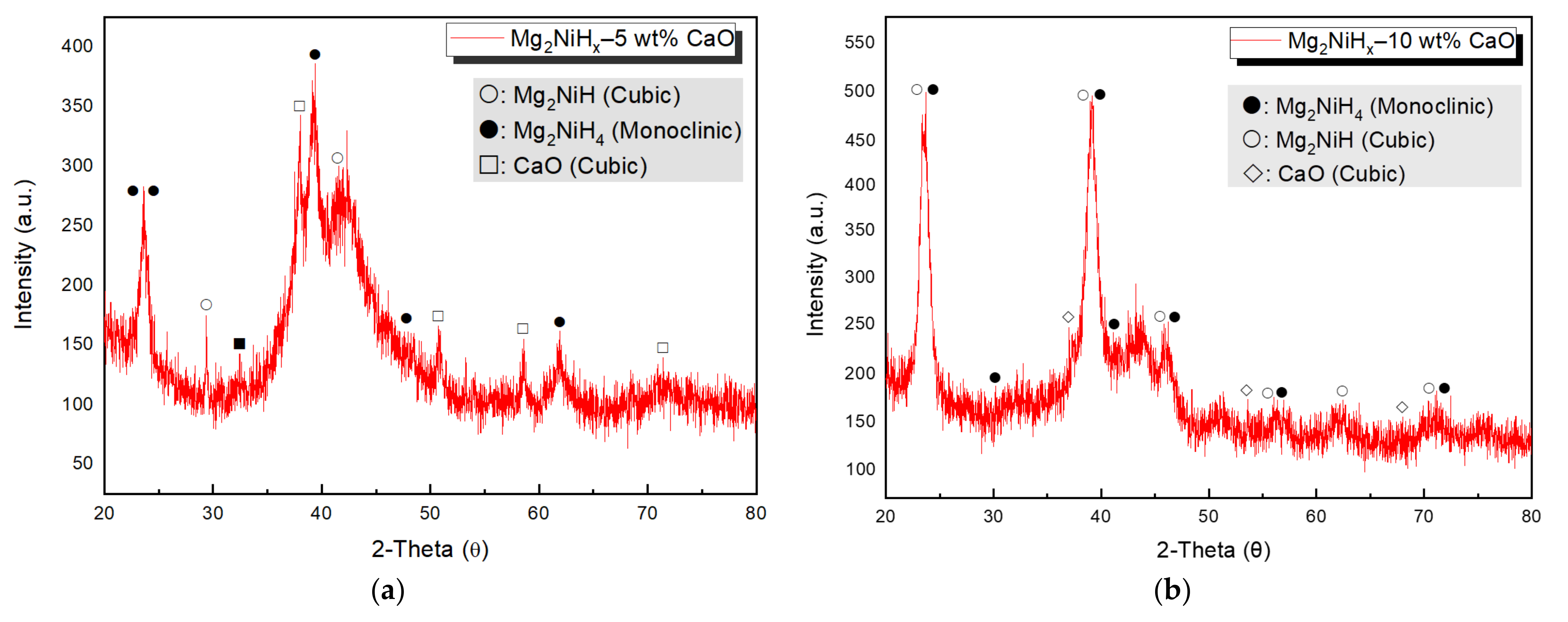
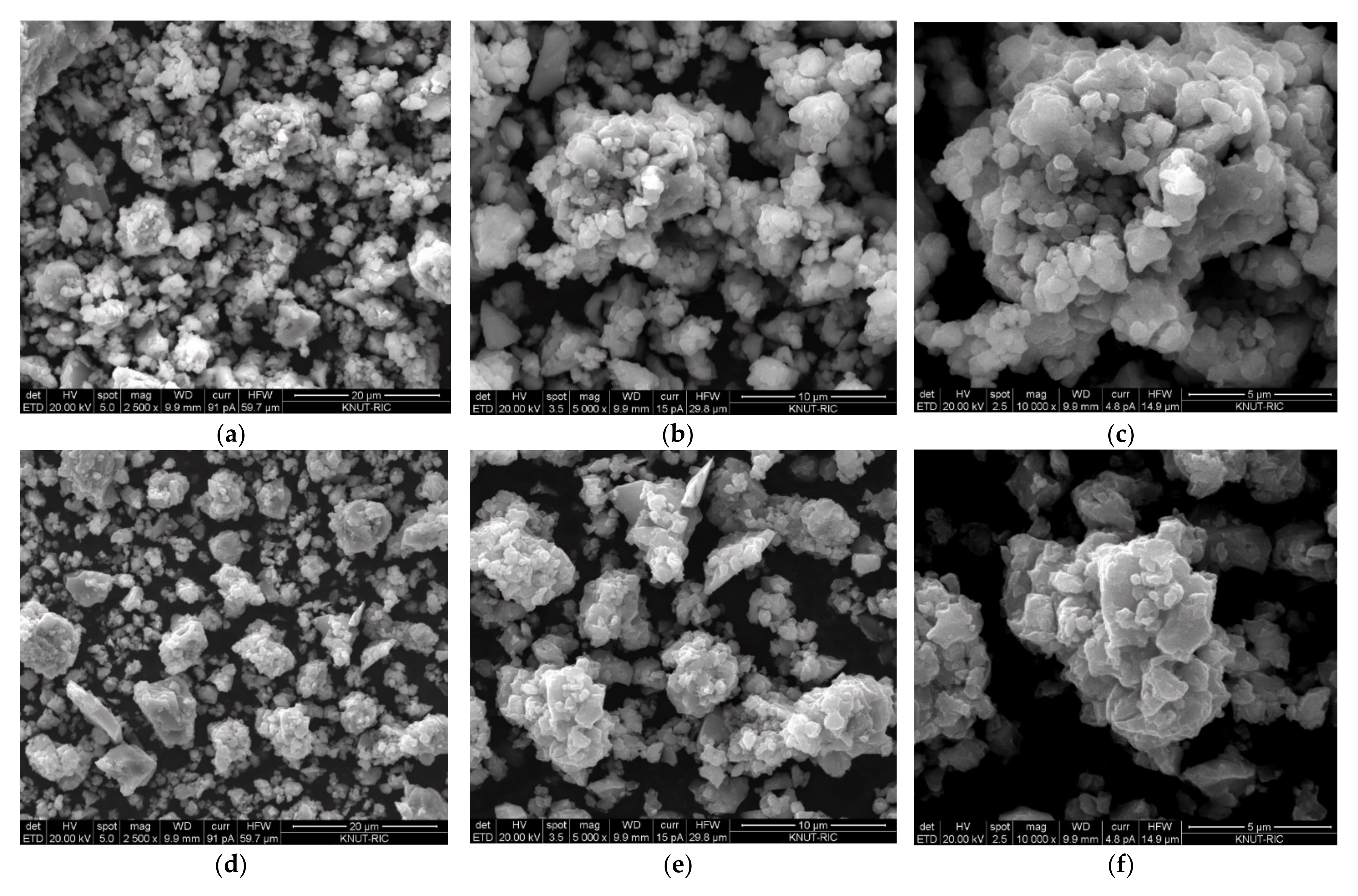
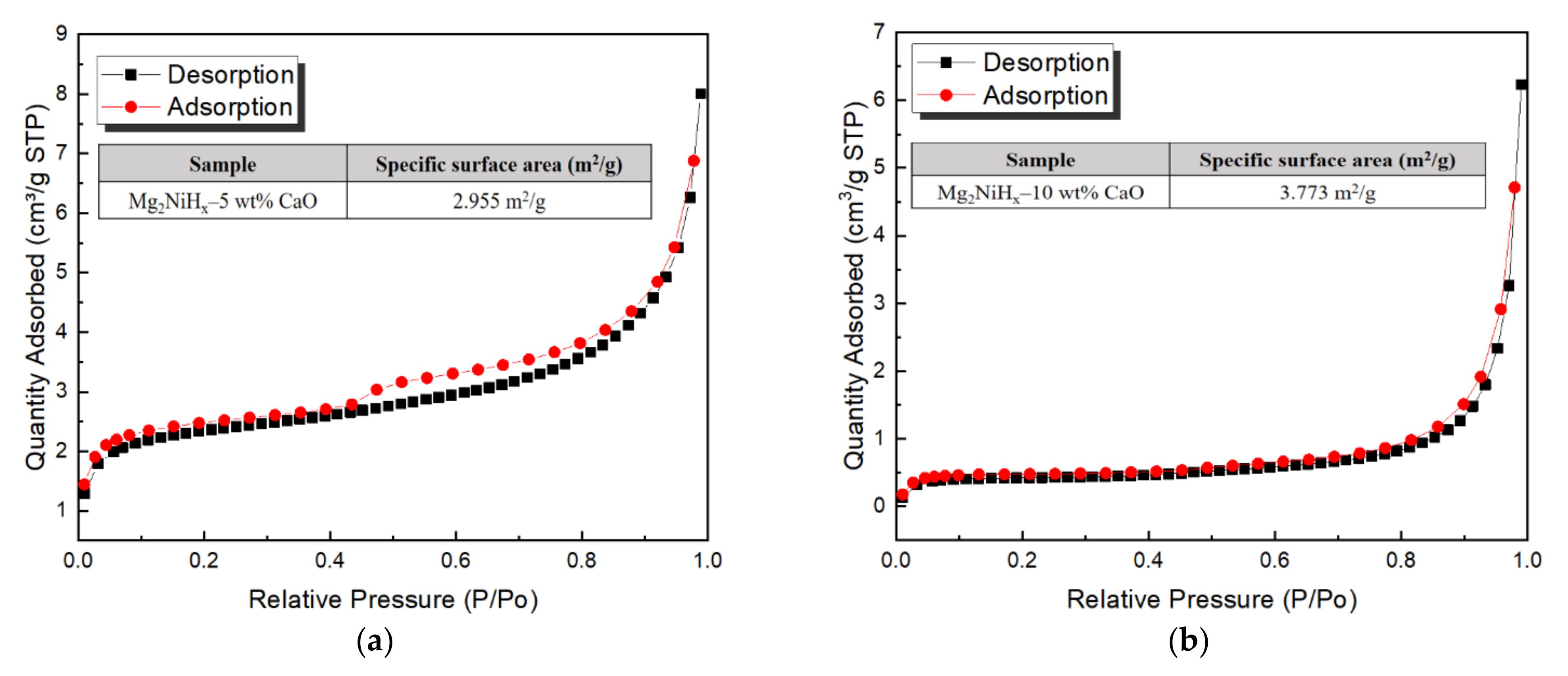

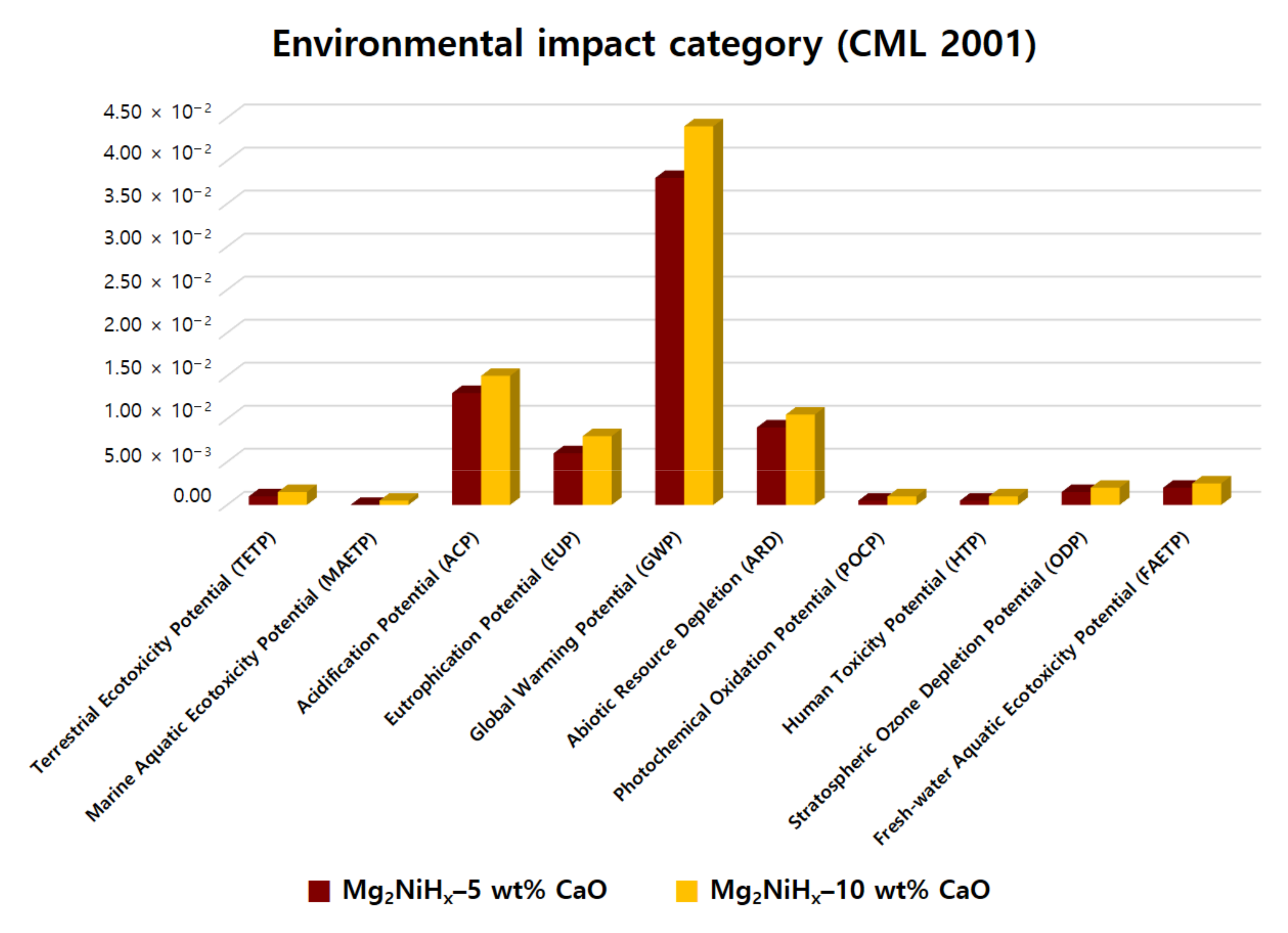
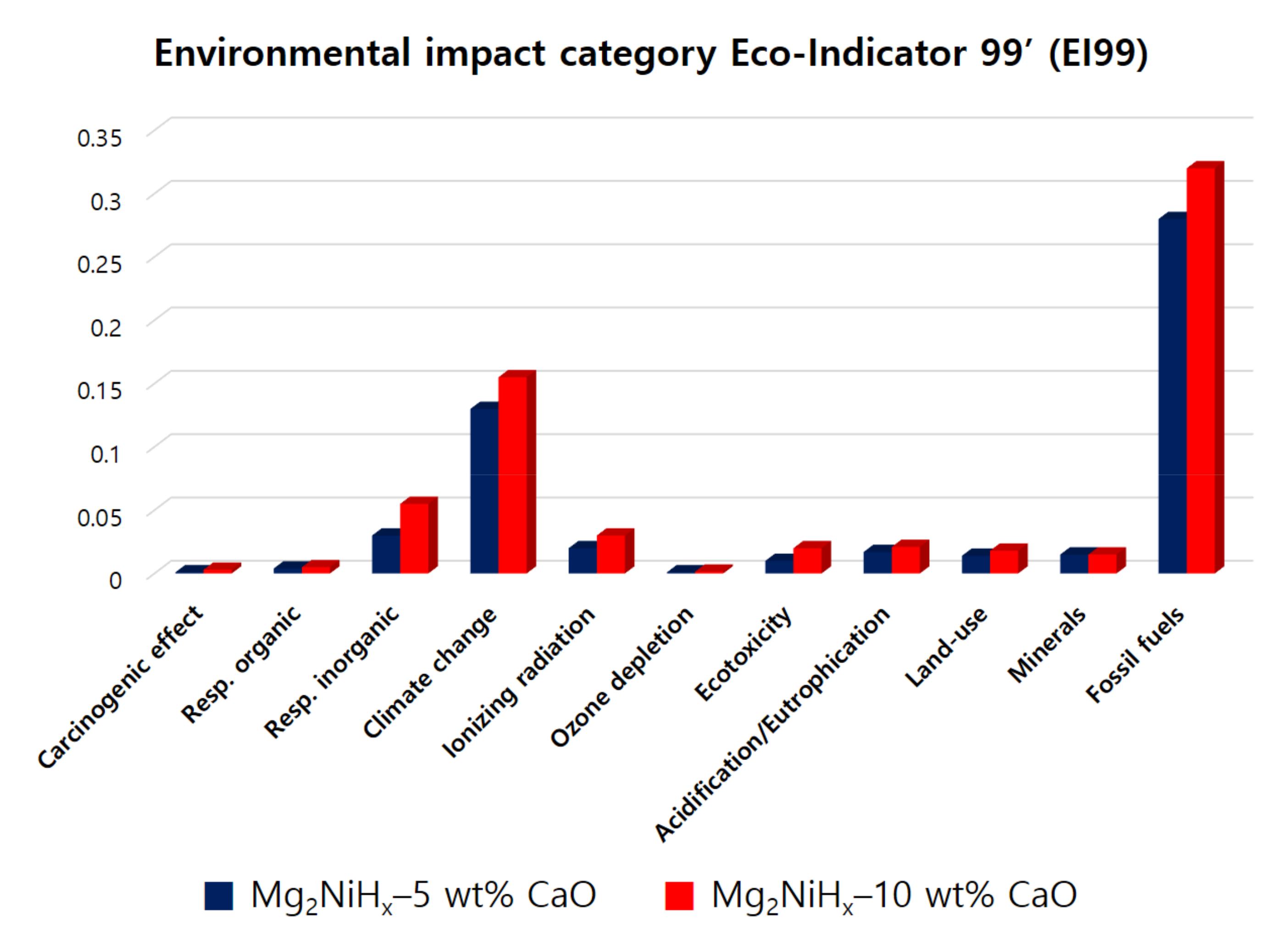
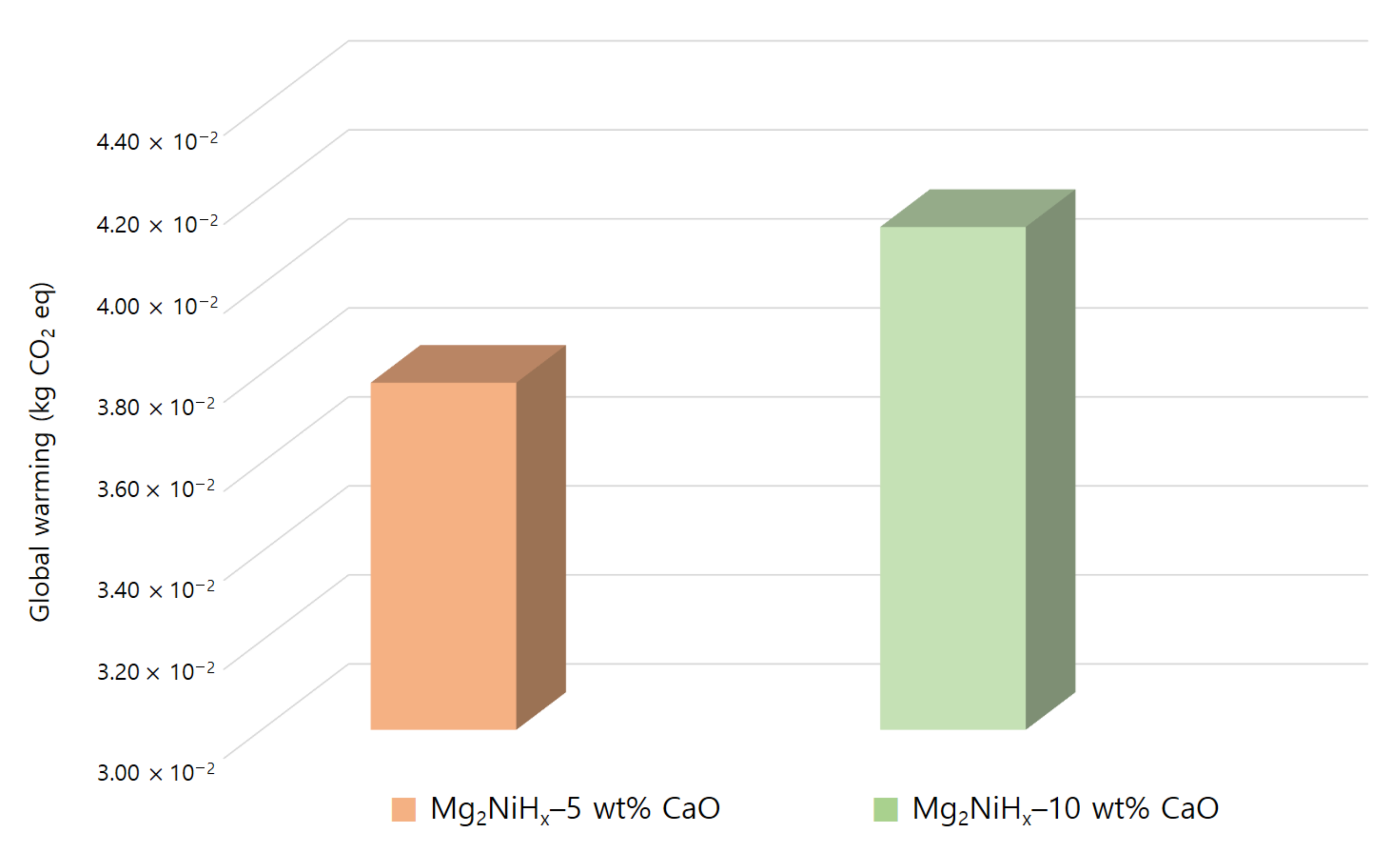
| Environmental Impact Categories | Unit | Life Cycle Environmental Impacts | |
|---|---|---|---|
| Mg2NiHx–5 wt% CaO | Mg2NiHx–10 wt% CaO | ||
| Abiotic Resource Depletion (ARD) | Kg yr−1 | 6.85 × 10−3 | 8.76 × 10−3 |
| Global Warming Potential (GWP) | Kg CO2 eq | 3.86 × 10−2 | 4.09 × 10−2 |
| Stratospheric Ozone Depletion Potential (ODP) | Kg CFC−11 eq | 1.69 × 10−5 | 2.57 × 10−5 |
| Photochemical Oxidation Potential (POCP) | Kg C2H4 eq | 1.41 × 10−5 | 3.64 × 10−5 |
| Acidification Potential (ACP) | Kg SO2 eq | 1.83 × 10−2 | 1.45 × 10−2 |
| Eutrophication Potential (EUP) | Kg PO4 eq | 5.14 × 10−3 | 5.69 × 10−3 |
| Fresh-water Aquatic Ecotoxicity Potential (FAETP) | Kg 1,4-DCB eq | 1.57 × 10−8 | 2.25 × 10−8 |
| Marine Aquatic Ecotoxicity Potential (MAETP) | Kg 1,4-DCB eq | 1.89 × 10−8 | 3.17 × 10−8 |
| Terrestrial Ecotoxicity Potential (TETP) | Kg 1,4-DCB eq | 3.14 × 10−4 | 5.33 × 10−4 |
| Human Toxicity Potential (HTP) | Kg 1,4-DCB eq | 7.25 × 10−8 | 7.74 × 10−8 |
| Damage Categories | Damage Unit | Life Cycle Environmental Impacts | ||
|---|---|---|---|---|
| Mg2NiHx–5 wt% CaO | Mg2NiHx–10 wt% CaO | |||
| Human health | Carcinogenic effect | DALY | 1.12 × 10−8 | 1.63 × 10−8 |
| Respiratory (organic) | DALY | 2.47 × 10−8 | 2.68 × 10−8 | |
| Respiratory (inorganic) | DALY | 2.98 × 10−2 | 5.02 × 10−2 | |
| Climate change | DALY | 1.16 × 10−1 | 1.48 × 10−1 | |
| Ionizing radiation | DALY | 2.03 × 10−2 | 2.15 × 10−2 | |
| Ozone depletion | DALY | 1.26 × 10−8 | 1.29 × 10−8 | |
| Ecosystem quality | Ecotoxicity | PDF × m2 × yr | 1.32 × 10−2 | 2.11 × 10−2 |
| Acidification/Eutrophication | PDF × m2 × yr | 1.84 × 10−2 | 1.95 × 10−2 | |
| Land-use | PDF × m2 × yr | 1.16 × 10−2 | 1.19 × 10−2 | |
| Resources | Minerals | MJ | 1.73 × 10−2 | 1.82 × 10−2 |
| Fossil | MJ | 2.71 × 10−1 | 3.18 × 10−1 | |
Publisher’s Note: MDPI stays neutral with regard to jurisdictional claims in published maps and institutional affiliations. |
© 2021 by the authors. Licensee MDPI, Basel, Switzerland. This article is an open access article distributed under the terms and conditions of the Creative Commons Attribution (CC BY) license (https://creativecommons.org/licenses/by/4.0/).
Share and Cite
Shin, H.-W.; Hwang, J.-H.; Kim, E.-A.; Hong, T.-W. Evaluation of Hydrogenation Kinetics and Life Cycle Assessment on Mg2NiHx–CaO Composites. Materials 2021, 14, 2848. https://doi.org/10.3390/ma14112848
Shin H-W, Hwang J-H, Kim E-A, Hong T-W. Evaluation of Hydrogenation Kinetics and Life Cycle Assessment on Mg2NiHx–CaO Composites. Materials. 2021; 14(11):2848. https://doi.org/10.3390/ma14112848
Chicago/Turabian StyleShin, Hyo-Won, June-Hyeon Hwang, Eun-A Kim, and Tae-Whan Hong. 2021. "Evaluation of Hydrogenation Kinetics and Life Cycle Assessment on Mg2NiHx–CaO Composites" Materials 14, no. 11: 2848. https://doi.org/10.3390/ma14112848
APA StyleShin, H.-W., Hwang, J.-H., Kim, E.-A., & Hong, T.-W. (2021). Evaluation of Hydrogenation Kinetics and Life Cycle Assessment on Mg2NiHx–CaO Composites. Materials, 14(11), 2848. https://doi.org/10.3390/ma14112848







